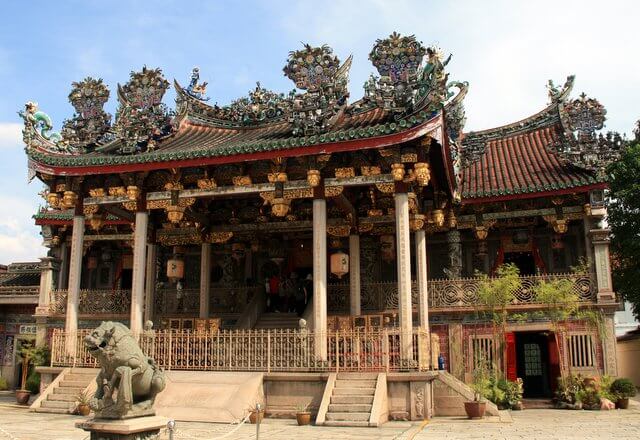
Leong San Tong Khoo Kongsi
Often referred to as the Pearl of the Orient, the name Penang derives from the Malay Pulau Pinang, which means Island of the Areca Nut Palm. Named after Britain’s King George III, Georgetown is the capital of Penang and since 2008 a UNESCO World Heritage Site.
Starting near the spot where Francis Light landed at the island on the 11st August 1786 and began over a century of British involvement in Malaysia we visited the Tourist Information centre by the Queen Victoria Memorial Clock Tower. On the other side of the road is Fort Cornwallis, a star-shaped structure completed in the early 19th century which served as the military and administrative centre of the island for the East India Company, but is now purely a tourist attraction. This is Past the War Memorial is the hundred year old City Hall which is still used for its original purpose, but the Town Hall next door evolved into a theatre, then a church and library and is once again the town’s meeting hall. Looking to the right from the corner here you can see Penang’s Court Building, the State Museum, St Georges Church and the Cathedral of the Assumption.
Walking away from the shore you enter Little India, home to the Penang’s Muslim Indian traders. Here you can find a microcosm of Indian life, with colourful array of clothing and crafts from all corners of India. Amongst the hustle and bustle of traders and blaring music is the relative calm of the Sri Mahamariamman temple. This is one of the oldest temples in Penang, dating back to 1801 and the gateway is sculptured with 38 Hindu deities. The hawker area nearby is an interesting place to stop for lunch to try the thosai rice flour pancake or a banana leaf meals which is a two-course vegetarian meal served on a folded banana leaf.
Passing through to the other side of Little India you’re presented the circular entrance to the equally overt ChinaTown, noticeable by the prevalence of Chinese characters on the shop signs and the ornate roof designs. Look closer and you’ll find all sorts of traditional Chinese craft shops, usually run by the artist themselves. Amongst this is Kong Hock Keong, the first temple built by Penang’s early Chinese settlers, dedicated to Kuan Yin, the Goddess of Mercy. We were there at the end of Chinese New Year and the celebrations were still in full swing, with street parades of floats containing people banging drums and setting firecrackers to scare away evil spirits for the coming year.
Somewhat hidden away in ChinaTown is the UNESCO World Heritage Site of Leong San Tong Khoo Kongsi. Leong San Tong refers to the Dragon Mountain Hall clan, and this is the kongsi (clanhouse) of the affiliated Khoo family. This is considered the finest clan temple outside of China, and despite the original burning down in 1894, the 1902 restoration is still a masterpiece of Chinese craftsmanship. This shows in the intricately carved ceilings and roofs and pillars. The complex consists of the main template, a single storey cookhouse and across the courtyard lies a full Chinese opera stage.
Following the underwhelming nature of the previous night’s food at Hawker Gurney we got a recommendation from a cab driver and ate at the small Kahleel restaurant, one of a chain of 4 across the island. Here we were treated to an Indian Muslim meal which was considerably simpler and more enjoyable than anything we’d had in Malaysia so far. For less than £2 we had a meal of Nasi Goreng (spicy rice) and Nasi Kandar (spicy rice with meats+seafood), then as the food was so good we followed up with an entirely unnecessary butter naan bread with a selection of vegetarian curry side dishes.






Pingback: raveable (@raveable)
Pingback: Malaysia Meta Guide (@meta_guide_my)